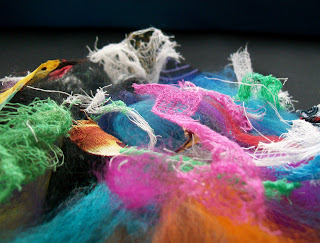I used two of the practice vessels to make some 'woolly vessels' by needle felting locks onto them. One of them was this white vessel. I needlefelted locks of Angora, Alpaca, Wensleydale, Bluefaced Leicester and Kid Mohair onto it, then put it through the washer to make sure the locks were secure, and because a lot of them were unwashed locks.
Another one I made was this bluey green one, it reminds me of something from under the sea or around the coast. This has dyed locks of Angora, Alpaca, Wensleydale, Devon, Bluefaced Leicester and Kid Mohair. And I used texturey wools like dyed Icelandic and scoured lambswool to secure the locks.
Around the same time, I had the idea for making a really colourful texturey vessel, by needlefelting pieces of handmade yarn and wool twists onto one of my spare practice vessels. I had quite a large stash of handmade yarn and often made wool twists for projects so thought it probably wouldn't take much longer than the other two had. I was wrong! :) It took a lot longer... about 3 years off and on. I probably could have finished it sooner, and I did have phases where I would make up twists and add them, or sit spinning yarn for a few hours then cut it into pieces when it was dry and spend a few hours needling pieces onto the vessel but it never seemed to get any closer to being done! This last weekend, not feeling well enought to tackle my half finished business plan, I decided to try my hardest to finish it. I got out all my left over yarn, stashes of wool blends and a drop spindle and set to work making a big pile of wool twists and a long length of plied yarn to cut up. I also got out my box of very thin felt offcuts and wetted and rubbed some of those to add too. I didn't want to wet the yarn and wait while it hung and dried, so after snipping it into lengths I wet and rubbed one end to 'seal' it and stop it unravelling. After needling all the pieces into the bare parts of the vessel, I finished off around the top, tidying it up and securing the loose fibres. And this is the result:
And then I put it into an old pillow case and put it in the washing machine with a normal load :) It looked like this:
I unsquashed it and gave it a few shakes and spins, ran my fingers loosely through the twists and yarns (there's a few strips of silk and organza n there too) then sat it on a tub to dry overnight. And this is what it looks like this morning:





.JPG)
.JPG)






.JPG)
.JPG)








.JPG)
.JPG)
.JPG)


























.JPG)
.JPG)





